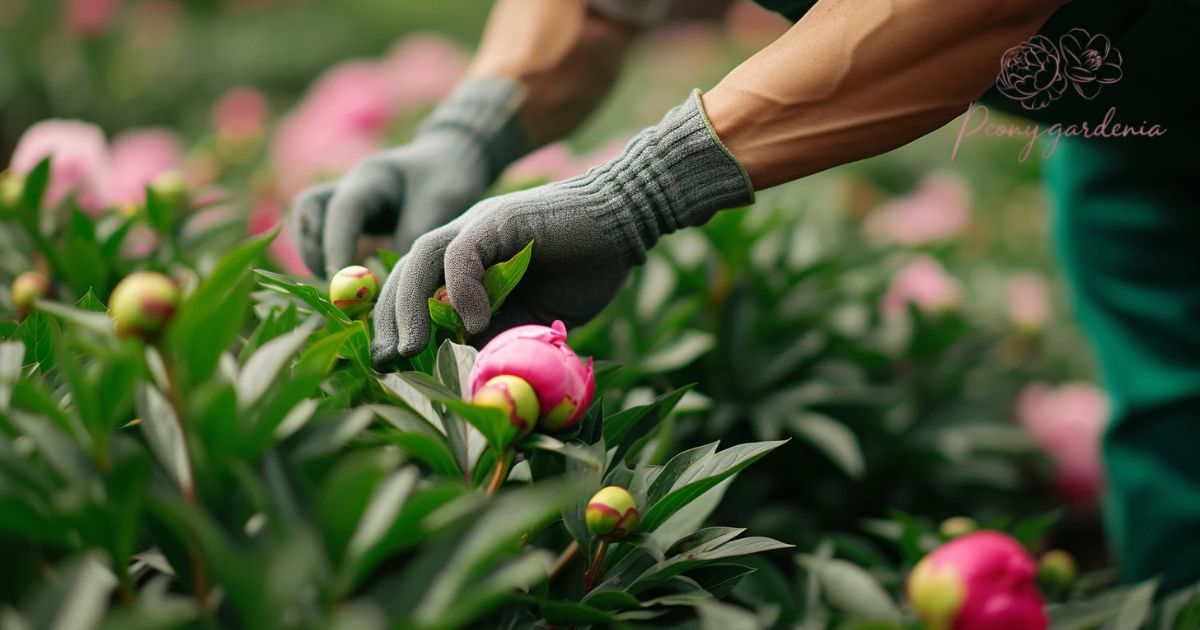Transplanting peonies can help them thrive in a better location with improved soil conditions. This process ensures healthy growth and beautiful blooms. With the right techniques, you can move your peony successfully without harming it.
In this guide, we will walk you through each step of transplanting peonies. From choosing the best time to replanting and caring for your new plant, these simple instructions will make the process easy and stress-free.
When to Transplant Peonies
The best time to transplant peonies is in the early fall or late winter while the plant is dormant. This timing minimizes shock and helps the peony establish new roots before the growing season begins. Avoid transplanting during the spring when the plant is actively growing, as this could stress it.
Signs that your peony needs to be transplanted include crowded roots, poor bloom production, or if the plant is suffering from soil compaction. It’s also a good time to move peonies if you want to replant them in a spot with better light and air circulation.
Where to Transplant Peonies
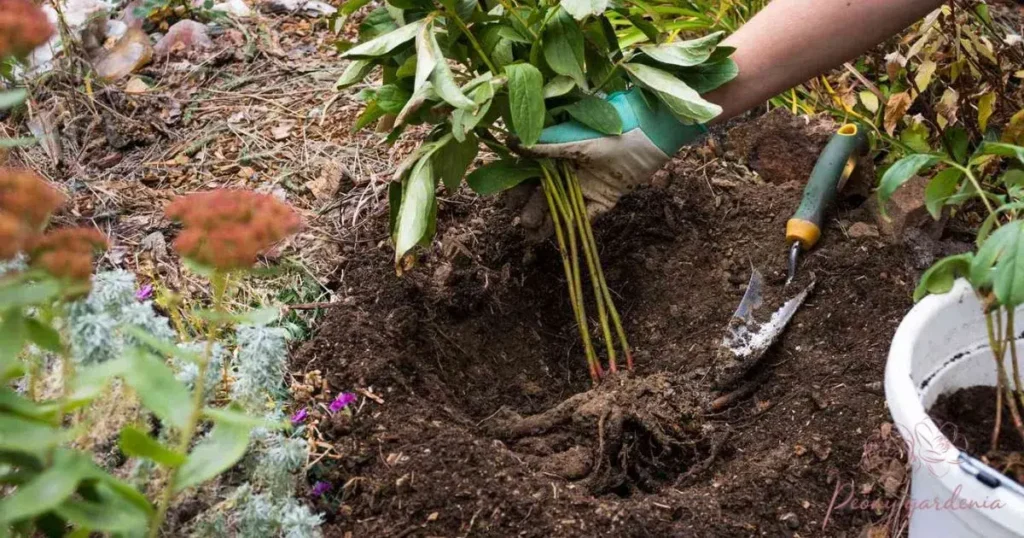
Peonies need a location with full sun exposure for at least six hours daily to thrive. Choose an area with well-draining soil that isn’t too rich in nitrogen, which can hinder bloom production. The site should allow enough space for the peony to spread its roots and grow healthily.
Avoid areas prone to standing water, as peonies do not tolerate wet feet. Additionally, consider the plant’s future size, as peonies can grow large, so ensure the area has enough space for it to expand. Proper placement helps ensure a long, healthy life for your peony.
Read More: Who Is Fragrance in Peony Pavilion?
Preparing Your Peonies for Transplanting
Before transplanting, prepare your peonies by watering them a day before digging. This will help reduce stress on the plant and make it easier to lift the roots from the soil. Depending on the type, you might need to prune or cut back the foliage to make the transplant process smoother.
Different types of peonies require slightly different approaches. Herbaceous peonies can be dug up easily, while tree peonies may need extra care to preserve their woody stems. Be sure to assess the type of peony before beginning the transplanting process.
How to Transplant Peonies: A Step-by-Step Guide
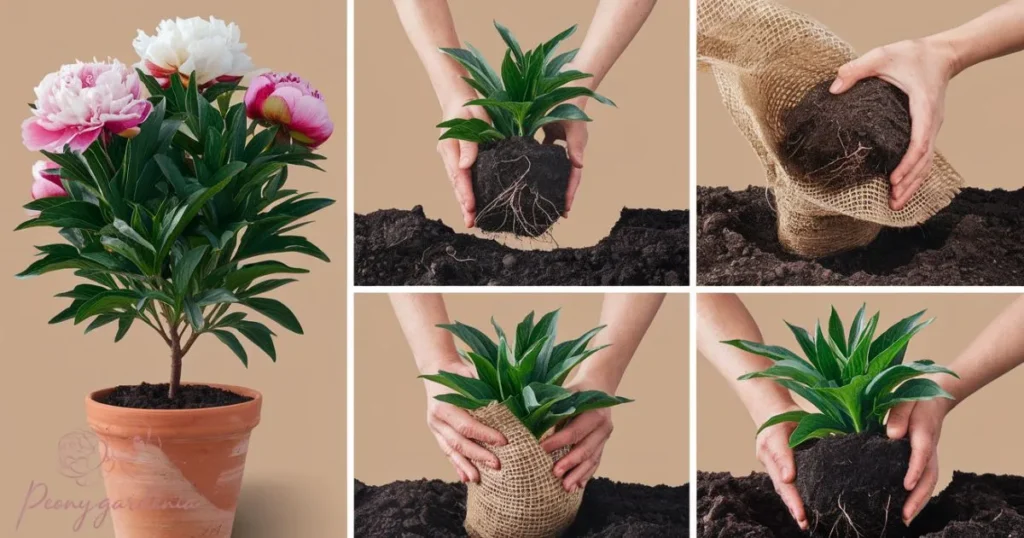
Transplanting peonies is a delicate process that requires careful planning. By selecting the right time, preparing the plant properly, and choosing the best location, you can ensure a smooth transition. With the right soil, spacing, and consistent care, your peonies will thrive and reward you with stunning blooms for years.
Step 1: Gently Dig Around the Plant
Start by digging around the peony about 6 to 12 inches from the base to avoid damaging the root system. Use a shovel to loosen the soil carefully, making sure not to disturb the plant too much. Take your time to make a clean cut around the roots for easier lifting.
Gently lifting the peony’s root ball requires patience, as rushing this process could harm the plant. Ensure the area around the plant is clear of any large rocks or debris before lifting it out. This will give you better control and prevent any unnecessary damage to the root structure.
Step 2: Loosen and Lift the Plant
Once the soil is loosened, use a garden fork to gently lift the peony from the ground. Make sure to keep the root ball intact while lifting to prevent breaking delicate roots. Be especially cautious when handling tree peonies, as their roots may be more fragile.
As you lift, try to keep as much of the root system intact as possible. Peonies don’t like to be disturbed too much, so preserving the roots is essential for the plant’s recovery. Gently shake off the excess soil to reveal the root structure.
Step 3: Rinse the Roots
After lifting the peony, rinse the roots gently with a garden hose or bucket of water. This will help you inspect the health of the roots, removing dirt and exposing any issues. Healthy roots should appear firm and white or light tan in color.
If you spot any diseased or damaged roots, prune them away with sterilized pruning shears. Removing unhealthy roots will help the plant focus energy on healthy growth. Proper root care is crucial for a successful transplant.
Step 4: Dig a New Hole
Dig a hole in the new location that’s about twice the size of the root ball. The hole should be deep enough to accommodate the peony’s roots without crowding them. Make sure the new site offers well-draining soil for the best results.
Peonies prefer slightly acidic to neutral soil, so consider testing the pH before planting. The new hole should be wide enough to allow the roots to spread freely, ensuring they aren’t cramped. Space is key to healthy root development.
Step 5: Amend Your Soil
Before placing the peony in the hole, improve the soil by adding compost or organic matter. This will provide extra nutrients and improve drainage, which peonies need to thrive. Avoid over-amending, as peonies don’t like overly rich soil.
Peonies also do well with a light layer of bone meal or slow-release fertilizer to promote strong root growth. However, be cautious with fertilizers, as too much nitrogen can harm peonies by encouraging foliage growth over flowers. A balanced approach is best.
Step 6: Place the Plant in the New Hole
Place the peony in the new hole, making sure the crown of the plant is level with or slightly above the soil surface. Planting it too deep can cause the peony to struggle with blooming. Ensure that the roots are spread out and not tangled.
Position the peony so that it faces the best direction for sunlight exposure, typically toward the east or south. This will help the plant receive optimal light for healthy growth and flowering. Avoid crowding the peony with other plants.
Step 7: Water the Plant
Once the peony is in place, water it thoroughly to settle the soil around the roots. This helps remove air pockets and ensures the plant is well-hydrated. Keep the soil moist but not soggy for the first few weeks after transplanting.
Watering deeply ensures the roots can start to establish themselves in the new soil. Avoid shallow watering, as this can encourage shallow root growth. Regular watering during the plant’s early growth will promote a strong and healthy foundation
How to Divide Peonies
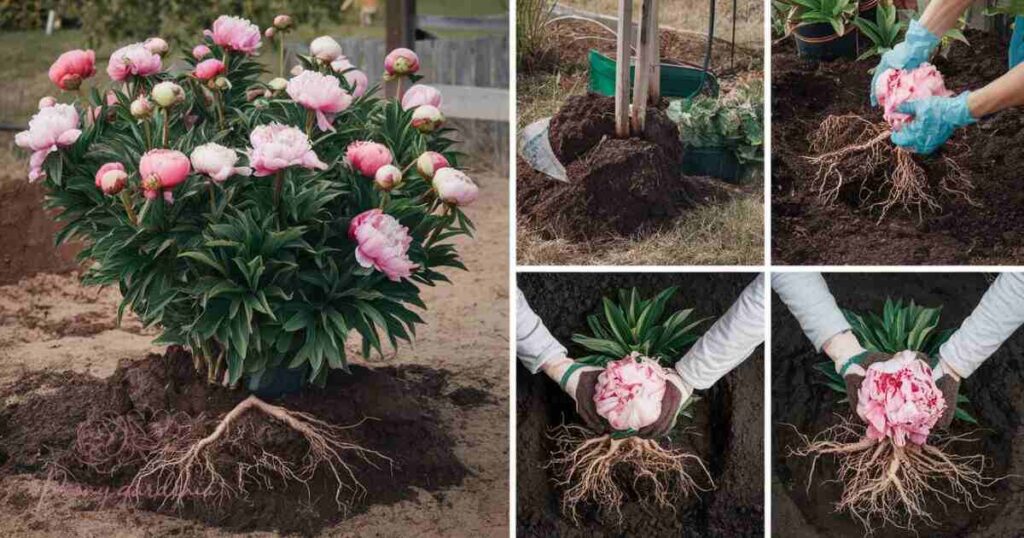
Dividing peonies can be done to rejuvenate old plants or create new ones. To divide, wait until the plant is dormant, then carefully dig it up and separate the root clumps. Be sure each division has at least one healthy eye or bud to ensure new growth.
Dividing peonies allows you to spread them across your garden or share them with friends. It’s also an effective way to reduce overcrowding in the garden, helping all plants thrive. Ensure the divisions are spaced properly when replanting to avoid root competition.
Caring for New Peony Transplants
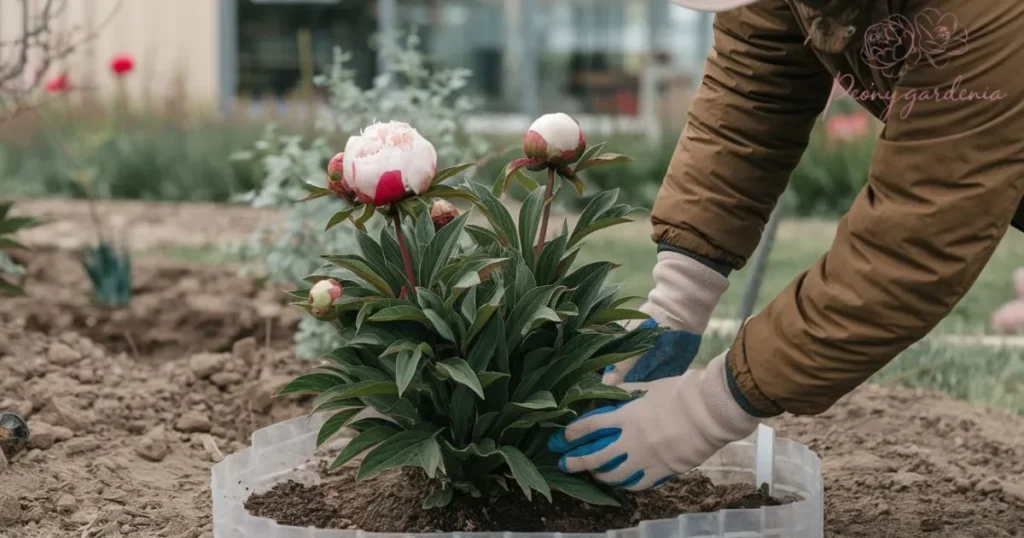
After transplanting, peonies need regular care to establish strong roots. Water them consistently but avoid over-watering, which can lead to root rot. Adding a layer of mulch around the plant will help retain moisture and regulate soil temperature.
Peonies will need to be monitored for the first growing season. Ensure they receive adequate sunlight and be on the lookout for pests or diseases. Once the plant is well-established, it will be less reliant on frequent care but will continue to benefit from occasional maintenance.
Conclusion
In conclusion, transplanting peonies can be a rewarding experience if done with the right techniques and care. By understanding when and where to transplant, as well as preparing the plant properly, you can ensure its successful relocation. The step-by-step guide, from gently digging around the plant to watering it after replanting, is essential for minimizing stress and promoting healthy growth.
Additionally, dividing peonies when necessary can help rejuvenate the plant and spread its beauty throughout your garden. With proper post-transplant care, including adequate watering, mulching, and monitoring, your peony will establish strong roots and flourish in its new location. Patience and attention to detail will lead to vibrant blooms year after year.
FAQs
When is the best time to transplant peonies?
The best time to transplant peonies is in early fall or late winter when they are dormant.
Can I transplant peonies in the spring?
It’s not recommended to transplant peonies in the spring, as they are actively growing and may experience stress.
How deep should I plant peonies?
Peonies should be planted with their crown level with or slightly above the soil surface.
How often should I water peonies after transplanting?
Water peonies deeply once a week, ensuring the soil remains moist but not soggy.
Can peonies be divided during transplanting?
Yes, peonies can be divided during transplanting to rejuvenate the plant or propagate new ones.
